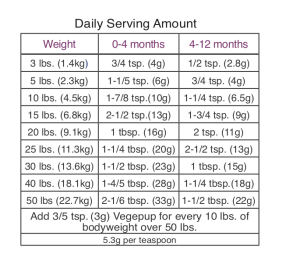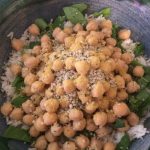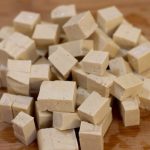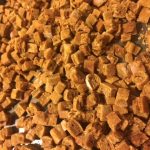Vegepup™ Recipe Instructions
Start with fresh ingredients and prepare food as you do for other family members.
If you use recipes from Dr. Pitcairn’s Complete Guide to Natural Health for Dogs & Cats, add the Vegepup supplement based on the following guide: Dr. Pitcairn’s Vegepup Recipe Modifications [pdf download]
How much should you feed?
Ask your veterinarian, or use a reputable on-line calorie calculator, to determine how many calories to feed your puppy or dog per day, based on age and weight.
One on-line calculator we really like is Vetcalculators.com.
Be sure to weigh your puppy regularly and adjust the number of calories you are feeding. Puppies under about 4-months of age need more calories per pound of body weight than older puppies. Be sure to check the calorie calculator for a new calorie recommendation when you hit the 4-month mark.
To find out how many calories per cup your home-prepared meal yields, prepare your meal and then measure how many cups your recipe made with a measuring cup. Our recipes list the total number of calories in the recipe under the recipe title (also listed in the chart below). Divide the recipe calorie total by the number of cups your recipe yields. For example, if you end up with 9-1/2 cups of food from the garbanzo recipe, your food is 299 calories per cup. [2837 ÷ 9.5 = 298.6]
Due to variations in ingredients, the amount of water used, cook times and methods, whether you mash or puree your meals, the vegetables you add, etc., everyone is going to end up with a different volume of food from our recipes. The above method is the most accurate way to determine how much to feed. That said, each recipe below gives an estimate of how many cups it yields, and how many calories per cup, prior to blending or mashing and adding vegetables.
There are 16 tablespoons in one cup. If you’d like to find out how many calories are in one tablespoon, divide the number of calories in one cup by 16. If one cup contains 378 calories, one tablespoon contains 23.6 calories. [378 ÷ 16 = 23.6]
Example: If you have a 3-month old puppy who weighs 10 lbs, the above calorie calculator recommends feeding 654 calories per day. Let’s say you prepare the Lentil Recipe and end up with 9-1/2 cups of a whole lentil food. Since the recipe is a total of 2755 calories, you have 290 calories per cup.
If you were to feed your puppy this food, you’d need to feed 2-1/4 cups per day, though the amount of veggies you add will increase the amount. [654 (calories) ÷ 290 (calories per cup) = 2.25 (or 2-1/4) cups per day]
If you want to make the food easier to digest, you can blend the food in the blender and might end up with 7 cups of food. Again, the entire recipe contains 2755 calories. 2755 (calories) ÷ 7 (cups) = 393 calories per cup. Now your blended lentil recipe contains 393 calories per cup.
To feed your little one 654 calories in a day, you divide the the number of calories you want to feed by the number of calories in a cup of your food. 654 (calories) ÷ 393 (calories per cup) = 1.66 (or 1-2/3) cups per day
Please do not stress too much about this. You don’t have to have everything exactly right down to the tablespoon or calorie. If you have questions, contact us from the contact page. We are happy to help!
Transition Gradually
Mix a small amount of the new food in with the old food and adjust the proportions over a week or longer. You can start with up to 25% new food on the first day. Digestive enzymes are especially beneficial during the transition, while the digestive tract makes adjustments.
Organic & Non-GMO Ingredients
GMO (Genetically Modified Organism) ingredients and herbicides can cause gastrointestinal issues, food allergies, and more. Soy, canola, and corn that is not organic IS almost certainly genetically modified in the USA. Compassion Circle strongly recommends organic food for you and your animals!
Digestive Enzymes
Almost every process in the body requires enzymes. Digestion is no different. Digestive enzymes are produced in the body and found in plants and raw foods. These enzymes are heat sensitive, so cooking and processing food destroys the natural enzymes. We recommend adding plant-derived enzymes (lipase, amylase, protease, and cellulase) to any cooked food. Amylase is a particularly important aid for the digestion of carbohydrates. A little raw food doesn’t supply enough enzymes to compensate for the enzyme loss in cooked food. The Compassion Circle Digestive Enzymes should be available by late Summer of 2021.
Vegetables - YES, Please!
Adding vegetables (but never onions) to your puppy’s food is ideal. A variety of veggies in the diet adds few calories, but valuable, easily-absorbed vitamins and minerals. While our recipes meet nutritional requirements without the addition of vegetables, we highly recommend adding veggies to make up about 10% of the diet. Add lightly steamed or raw veggies; pureed or chopped – carrots, broccoli, green beans, cauliflower, squash or pumpkin, tomatoes, turnips, and more. Creamed or pureed corn is a good addition to meals, as are purees with a base of kale, lettuce, and other greens. Raw apples, cucumbers, berries, and melon can be added to purees or given alone as treats.It is ideal to add purees or steamed veggies to dry kibble because this increases the water content of the food and improves urine concentration.
Food Yeast - VegeYeast
Food yeast adds high quality protein, B vitamins, and flavor while helping deter fleas. Our VegeYeast is a modified Brewer’s yeast. It is more acidic than other yeast powders, thus beneficial for the urinary health of puppies and dogs. Stir yeast powder into the food so chunks are uniformly coated.
You can use nutritional yeast or regular Brewer’s yeast in recipes if you prefer. Nutritional yeast tastes cheese-like, and comes in maxi-flakes, mini-flakes, and powder. When using maxi-flakes, double the volume (not the weight) measurement.
Initially, it is best to weigh out the type of yeast you choose to use, in grams, on a kitchen scale. The gram measurements in the recipes are more accurate than the volume measures. Yeast is required to meet the B vitamin requirements for your puppy or pregnant/lactating dog. If a yeast allergy is present, you may substitute a crushed, 50mg B complex vitamin in each recipe below. The Vegepup™ supplement does contain a small amount of selenium yeast. If your animal has a severe yeast allergy, our supplements are not recommended.
OIL - EFAs ARE IMPORTANT
Essential Fatty Acids (EFAs) are particularly important during the growth stage. The omega-6 fatty acid, linoleic acid (LA), is especially important. Dogs and puppies can produce the other fatty acids they need with enough linoleic acid in the diet. This includes the production of arachidonic acid.
When a recipe calls for sunflower oil, it is to meet the linoleic acid (LA) requirement. This is important! The following oils are a comparable substitute for sunflower oil: safflower oil, evening primrose oil, grape seed oil, and hemp oil. If you use a different oil, understand that your dog needs 1/2 teaspoon (2.47mL) of one of the above oils for every 15 lbs (6.8kg) of body weight each day to meat the linoleic acid requirement.
Omega-3 fatty acids, specifically linolenic acid (ALA), come from the flax ingredients in the recipes. You may substitute 2/3 a teaspoon (3.3mL) of flaxseed oil for 1 tablespoon (7g) of ground flaxseed, or vice versa.
Store oils in the refrigerator. Smell and taste them before use to be sure they are not rancid.
Seasonings
Imitation bacon bits, stevia (a sweet herb)*, imitation meat, spirulina, pureed vegetables, and favorite table scraps from your own meals increase palatability, although you’ll find it hardly necessary for palatability.
*DO NOT use xylitol in dog food. It is toxic.
Textured Soy Protein (TVP)
Textured soy protein (TSP), also known as textured vegetable protein (TVP®) or soya chunks, is a defatted soy flour. Measure TSP before reconstituting it with water or low sodium broth. Recipes refer to the dry measure of TSP. Add 7/8 cup of boiling water (207mL) to each cup of dry TSP (95-120g). Let the powder or flakes completely absorb the liquid. Textured soy protein chunks (which are larger) may require a brief simmering before ready for use. Recipe cup measures are based on 1 cup of dry TSP weighing 105 grams. This does vary from product to product. Use the dry gram measure for best accuracy. Again, we recommend using organic, non-GMO soy products.
About the Recipes
Young puppies need 2 times more calories per pound of body weight than an adult dog. They eat more per pound of body weight (and more often) and need the added nutrients in Vegepup™. Pregnant or lactating mamas also eat considerably more than average adults. While not ideal, adult dogs who are not pregnant or lactating may eat recipes prepared with the Vegepup™ supplement. Ideally, the Vegedog™ supplement and recipes should be used for dogs 12-months of age and older.
The Vegepup™ supplement needn’t be cooked or heated. It can be added after meals are prepared, but it is best to mix the supplement into warm food. Ingredients can be prepared separately, then mixed together, or you may come up with your own method. Prepared meals can be stored in the refrigerator or freezer, with or without the supplement.

Our Vegepup™ recipes have the amount of Vegepup™ factored into the recipe. If you modify our recipes, please only substitute legumes for legumes or grains for grains, and be mindful of the protein content in your puppy’s diet; it should be roughly 30%.
A puppy over 4-months of age weighing 15 lbs. (6.8kg) would get 1-3/4 teaspoons (9g) of Vegepup™ per day. See the adjacent serving size chart to determine the daily serving size for your puppy’s age and weight. Mix the daily serving amount into the total amount of daily food, or divide it between daily meals.
On average, recipes need 1 tablespoon (15g) of Vegepup for every 1000 calories or 3 tablespoons (45g) of Vegepup for every 3000 calories in the recipe.
Garbanzos for Puppies
Ingredients
- 3-1/3 cups dry garbanzo beans (655g) Soak overnight and cook.
- 2 tbsp VegeYeast or nutritional yeast (18g) If using nutritional yeast, see label to achieve 18 grams. You may need more than 2 tablespoons.
- 4 tbsp hemp hearts (hemp meal) (40g)
- 1 tbsp ground flaxseed (7g)
- 2-3/4 tbsp Vegepup (40g)
- 1-1/4 tsp salt (5.8g) OR 2-1/4 tbsp. soy sauce (40g)
- Optional: Seasonings such as parsley, basil, spirulina, AND/OR up to 1 cup steamed or chopped veggies (150g).
Instructions
- Soak garbanzo beans overnight. The water level should be a few inches over the beans to allow for expansion. Change water before cooking. Cook according to package directions.
- If using canned garbanzo beans, use 8-2/3 cups canned beans (2kg), and do not add additional salt or soy sauce.
- Remove beans from heat and add other ingredients.
- Mix well.
Notes
Lentils for Puppies
Ingredients
- 3-1/3 cup uncooked/dry lentils (620g) Soak and cook before adding to meal.
- 1 tbsp VegeYeast or nutritional yeast (9g) If using nutritional yeast, see label to achieve 9 grams. You may need more than 1 tablespoon.
- 3-1/4 tbsp sunflower or organic canola oil (45g)
- 1 tbsp flaxseed oil (15g)
- 1-1/8 tsp salt (6.6g) OR 2-2/3 tbsp. soy sauce (47g)
- Optional: Seasonings such as parsley, basil, spirulina, AND/OR up to 1 cup steamed or chopped veggies (150g).
Instructions
- Soak lentils in cold water for 2 hours.
- Drain, cover with fresh water, and cook until soft.
- Drain cooked lentils.
- Add remaining ingredients and mix.
Notes
Oat & Tofu for Puppies
Ingredients
- 5 scant cups cups uncooked oats (400g) This makes about 8-1/2 cups (2kg) when cooked. See the gram measure on your oats to determine 400g of dry oats.
- 33 oz extra firm tofu (935g) About 3-3/4 cups; use ounce (or gram) measure from package to be most accurate.
- 1/2 cup tomato paste (132g)
- 1 tbsp VegeYeast or nutritional yeast (9g) If using nutritional yeast, see label to achieve 9 grams. You may need more than 1 tablespoon.
- 1 tbsp ground flaxseed (7g)
- 2-3/4 tbsp Vegepup (40g)
- 1 tsp salt (5g) OR 2 tbsp. soy sauce (35g)
- Optional: Seasonings such as parsley, basil, spirulina, AND/OR up to 1 cup steamed or chopped veggies (150g).
Instructions
- Rinse and cook oats according to package. Use at least 2 cups of water per 1 cups of oats to cook. Allow oats to fully absorb water while cooking.
- Remove from heat.
- Add tomato paste, food yeast, flaxseed, Vegepup, salt or soy sauce, and optional veggies or superfoods. Mix well.
- Cut tofu and mix into meal.
Notes
Oat & TSP for Puppies
Ingredients
- 4 cups dry oats (330g) This makes about 7 cups when cooked (1.7kg). See the gram measure on your oats to determine 330 grams of dry oats.
- 1-1/3 cups dry textured soy protein (TSP) (140g). Reconstitute dry TSP with 1 cup of water (237mL).
- 1/2 tbsp VegeYeast or nutritional yeast (4.5g) If using nutritional yeast, see label to achieve 4.5 grams. You may need more than 1/2 tablespoons.
- 1-1/2 tbsp ground flaxseed (12g)
- 1 tbsp sunflower, olive, or organic canola oil (14g)
- 1-5/6 tbsp Vegepup (28g)
- 3/4 tsp salt (4g) OR 1-1/2 tbsp. soy sauce (27g)
- Optional: Seasonings such as parsley, basil, spirulina, AND/OR up to 3/4 cup steamed or chopped veggies (115g).
Instructions
- Rinse and cook oats according to package. Use at least 2 cups of water per 1 cups of oats to cook. Allow oats to fully absorb water while cooking.
- Reconstitute dry TSP with 1 cup of water (237mL) by adding boiling water to TSP and mixing well. If using larger chunks, they might need to be simmered in water on the stove top. See TSP directions and prepare accordingly.
- Mix all ingredients together well.
Notes
Rice & Soy for Puppies
Ingredients
- 1-2/3 cups uncooked rice (293g) This makes roughly 5 to 5-1/2 cups when cooked.
- 2 cups dry textured soy protein (TSP) (200g). Reconstitute dry TSP with a little more less than 2 cup of water (415mL).
- 1-1/2 tbsp VegeYeast or nutritional yeast (13.5g) If using nutritional yeast, see label to achieve 13.5 grams. You may need more than 1-1/2 tablespoons.
- 2 tbsp sunflower or organic canola oil (28g)
- 1 tbsp flaxseed oil (14g)
- 2-1/3 tbsp Vegepup (35g)
- 3/4 tsp salt (4g) OR 1-1/2 tbsp. soy sauce (28g)
- Optional: Seasonings such as parsley, basil, spirulina, and/or up to 3/4 cup steamed or chopped veggies (113g).
Instructions
- Rinse rice well. Even better, soak for a short time and then change water before cooking. Cook according to package directions. It's best to add a little extra water and cook a little longer so rice fully absorbs water and is a soft texture.
- You may substitute quinoa for rice. Begin with 2 cups quinoa, rinse well, and cook according to package directions.
- Reconstitute dry TSP with a little more less than 2 cup of water (415mL) by adding boiling water to TSP and mixing well. If using larger chunks, they might need to be simmered in water on the stove top. See TSP directions and prepare accordingly.
- Mix all ingredients together well.
Notes
Soy Kibble for Puppies
Ingredients
- 3-1/3 cups whole wheat flour (520g)
- 4 cups whole soy flour (364g)
- 1-1/2 tbsp ground flaxseed (10.5g)
- 3 tbsp VegeYeast or nutritional yeast (25g) If using nutritional yeast, check package and add 25 grams. Could require more than 3 tablespoons if flakes are large.
- 3-1/2 tbsp Vegepup (53g)
- 1-1/3 tsp salt (7.6g) OR 3 tbsp. soy sauce (53g)
- 2-1/3 tbsp sunflower oil (32g)
- 3-3/4 cups water (889mL) Use more or less as needed.
Instructions
- Preheat oven to 300°F (150˚C).
- Combine all dry ingredients and mix well.
- Add wet ingredients and stir with a strong spoon to for dough.
- Flour hands and counter top to keep dough from sticking. Empty the bowl onto the counter top. Knead the dough by folding it on itself several times until smooth, proceeding as if making a pie crust.
- Roll dough to no more than 1/2” (1.25cm) thick, and smooth in place on a cookie sheet, kneading into corners. Cold dough is easier to work with. Okay to put in fridge or freezer for a short time.
- Prick dough with a fork to prevent bubbles.
- Bake for 30 minutes. Don’t bake so long that the edges get brown and brittle.
- Remove from oven and let cool slightly.
- With a large chef’s knife or pizza cutter, cut newly baked slab into 9 or 12 parts on a cutting board. Cut twice horizontally, and then cut vertically 2 or 3 times. Cut each of the resulting rectangles into kibble sized pieces by cutting first in one direction, and then the other. Piece sizes should be determined by the size of your puppy or dog.
- Separate kibble pieces onto two or more cookie sheets and place in a warm oven (at its lowest temperature) for two or three hours until crunchy dry. Direct sunshine is an energy efficient way to dry kibble, too. Kibble is dry enough when you can’t compress pieces with finger pressure.
Notes
For additional recipes and health information, see Dr. Pitcairn’s Complete Guide to Natural Health for Dogs & Cats (4th Edition) by Susan & Richard Pitcairn. Because the volume of the Vegepup™ supplement changed since the book’s first printing, serving size modifications may be necessary in the book’s growth (Vegepup™) recipes. You can add the supplement to food based on the daily serving size chart above (and on the product label), see our Dr. Pitcairn’s Guide Modifications chart, or base your addition on needing 1 tablespoon (15g) of Vegepup™ for every 1000 calories or 3 tablespoons (45g) of Vegepup™ for every 3000 calories in the recipe.
Visit our Green Mush™ information page, under the Vegan Pet Info drop down menu in the Main Menu bar, to find out more about this amazing, plant-based, pesticide-free, green superfood for animals. It’s a wonderful addition to any of our recipes!








